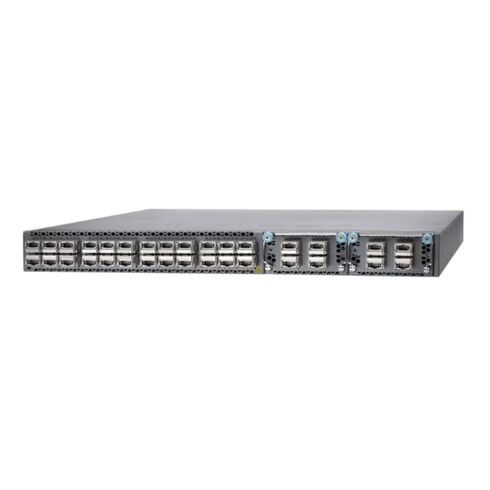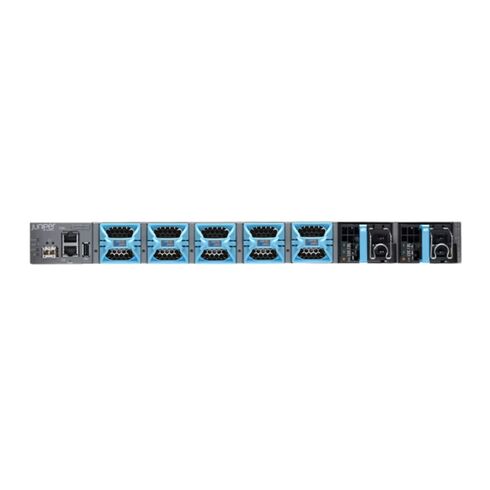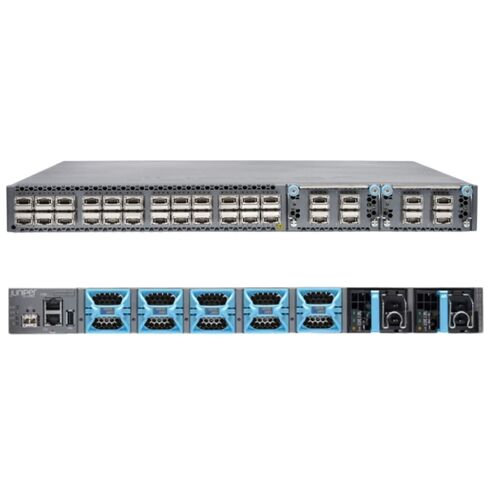QFX5100-24Q-DC-AFI Juniper 24-Port Rack Mountable Layer 3 Switch
- — Free Ground Shipping
- — Min. 6-month Replacement Warranty
- — Genuine/Authentic Products
- — Easy Return and Exchange
- — Different Payment Methods
- — Best Price
- — We Guarantee Price Matching
- — Tax-Exempt Facilities
- — 24/7 Live Chat, Phone Support
- — Visa, MasterCard, Discover, and Amex
- — JCB, Diners Club, UnionPay
- — PayPal, ACH/Bank Transfer (11% Off)
- — Apple Pay, Amazon Pay, Google Pay
- — Buy Now, Pay Later - Affirm, Afterpay
- — GOV/EDU/Institutions PO's Accepted
- — Invoices
- — Deliver Anywhere
- — Express Delivery in the USA and Worldwide
- — Ship to -APO -FPO
- — For USA - Free Ground Shipping
- — Worldwide - from $30
Product Overview: Juniper QFX5100-24Q-DC-AFI
The Juniper QFX5100-24Q-DC-AFI is a highly capable Layer 3 switch designed to enhance network performance and efficiency. This robust solution offers high-speed connectivity, versatility in port expansion, and environmentally-conscious features, making it an excellent choice for demanding IT environments.
Key Specifications
- Manufacturer Part Number: QFX5100-24Q-DC-AFI
- Brand: Juniper
- Type: Layer 3 Switch
Port and Expansion Details
Port Configuration
- Modular Ports: No
- Total Ports: 24 x 40 Gigabit Ethernet
- Expansion Slot: 24 x 40 Gigabit Ethernet Expansion Slot
Expansion Slot Information
- Expansion Slot Type: QSFP+
- Total Number of Expansion Slots: 26
Performance and Media
- Ethernet Technology: 40 Gigabit Ethernet
Network Features
Layer Support
- Supported Layer: Layer 3
Management and Protocols
- Manageability: Yes, the device is fully manageable
Power Specifications
Power Supply
- Primary Power Source: Power Supply
- Redundant Power Supply: Supported
Physical Dimensions
- Form Factor: Rack-mountable
- Compatible Rack Unit: 1U
- Height: 1.7 inches
- Width: 20.5 inches
- Depth: 17.4 inches
- Weight (Approx.): 21.60 lbs
Environmental Compliance
- Eco-Friendly: Yes
- Certifications: RoHS-6, WEEE, REACH
- Energy Efficiency: 80 Plus Silver Certified
- China RoHS Compliance: Yes
Ports
The Juniper QFX5100-24Q-DC-AFI Switch is equipped with 24 ports, making it an ideal choice for businesses and organizations looking to expand their network connectivity. These ports provide numerous benefits and play a crucial role in ensuring seamless communication and data transfer within a network.
Increased Connectivity
With 24 ports, this switch offers a significant increase in connectivity options compared to switches with fewer ports. This feature is especially beneficial for businesses that require a large number of devices to be connected to the network simultaneously. Whether it's connecting computers, servers, printers, or other network devices, the QFX5100-24Q-DC-AFI Switch can accommodate multiple connections, allowing for efficient and uninterrupted communication.
Flexibility and Scalability
The QFX5100-24Q-DC-AFI Switch's 24 ports provide flexibility and scalability to meet the evolving needs of businesses. With more ports available, users can easily add or remove devices from the network without significant disruptions. This scalability ensures that the network can grow alongside the organization, accommodating additional devices or expanding infrastructure as required.
Improved Performance
The 24 ports on this switch contribute to improved network performance by reducing congestion and bottlenecks. With more ports available, the switch can distribute network traffic more evenly, minimizing the chances of overloading any single port. This even distribution of traffic ensures that all connected devices can operate at their maximum potential, resulting in enhanced productivity and efficiency.
High-Speed Data Transfer
Each of the 24 ports on the QFX5100-24Q-DC-AFI Switch supports high-speed data transfer rates, allowing for quick and reliable communication between connected devices. Whether it's transferring large files, streaming media, or running bandwidth-intensive applications, users can expect fast and seamless data transfer across the network. This capability is particularly important for businesses that rely on real-time data processing or require high-speed connectivity for critical operations.
24 Ports for Increased Capacity
The inclusion of 24 ports in the QFX5100-24Q-DC-AFI Switch significantly increases the network's capacity to connect multiple devices simultaneously. This feature ensures that businesses can accommodate their growing networking needs without the need for additional switches or infrastructure. With 24 ports, users can connect numerous devices, such as workstations, servers, IP phones, and security cameras, all through a single switch.
Redundancy and Link Aggregation
The QFX5100-24Q-DC-AFI Switch supports link aggregation, which allows multiple ports to be combined into a single logical link. This feature provides redundancy and increased bandwidth by distributing network traffic across multiple physical connections. In case of a port failure, the switch can automatically redirect traffic to the remaining active ports, ensuring uninterrupted connectivity. Link aggregation also enhances network performance by allowing for load balancing, where traffic is evenly distributed across available links to prevent any single link from becoming overwhelmed.
Enhanced Network Security
The 24 ports on the QFX5100-24Q-DC-AFI Switch enable businesses to implement robust network security measures. Each port can be configured with specific security settings, such as access control lists (ACLs) and VLANs (Virtual Local Area Networks), to control and monitor traffic flow. By segmenting the network into smaller VLANs and applying ACLs, organizations can enhance security by limiting access to sensitive information and preventing unauthorized network access.
Port Mirroring
Another useful feature that the QFX5100-24Q-DC-AFI Switch offers is port mirroring. Port mirroring allows administrators to monitor network traffic by duplicating the packets from one port to another. This feature is particularly valuable for troubleshooting network issues, analyzing network traffic patterns, and implementing security measures. By mirroring traffic from specific ports, administrators can gain valuable insights into network behavior and identify potential bottlenecks or security threats.
Power over Ethernet (PoE)
Some models of the QFX5100-24Q-DC-AFI Switch offer Power over Ethernet (PoE) capabilities on select ports. PoE allows devices, such as IP phones, wireless access points, and surveillance cameras, to receive power and data through a single Ethernet cable. This eliminates the need for separate power sources and simplifies the installation process. With PoE support, businesses can easily deploy network devices without worrying about power availability near each device location.
Mountable
The Juniper QFX5100-24Q-DC-AFI Switch is designed to be rack-mountable, providing users with a convenient and space-saving solution for organizing their networking equipment. The rack-mountable feature offers several benefits and is highly valued by businesses and organizations with limited space or those looking to streamline their network infrastructure.
Optimal Space Utilization
Rack-mountable switches like the QFX5100-24Q-DC-AFI enable efficient use of space in server rooms or data centers. By mounting the switch in a standard 19-inch rack, users can vertically stack multiple networking devices in a compact manner. This vertical arrangement saves valuable floor space, allowing businesses to utilize their available area more effectively. It also simplifies cable management, reducing clutter and improving overall aesthetics.
Easy Installation and Maintenance
The rack-mountable design of the QFX5100-24Q-DC-AFI Switch makes installation and maintenance straightforward. With standardized rack mounting hardware, users can easily secure the switch in a rack without the need for additional tools or complicated setups. This simplicity extends to maintenance tasks, such as adding or replacing devices, as all the equipment is conveniently located and accessible within the rack. The organized layout and easy access simplify troubleshooting and reduce downtime in case of any issues.
Improved Airflow and Cooling
Rack-mountable switches promote better airflow and cooling compared to switches placed on a flat surface. The vertical arrangement of the devices allows for efficient air circulation, preventing heat buildup and ensuring optimal operating temperatures. This improved cooling capability helps prolong the lifespan of networking equipment and reduces the risk of malfunctions or performance degradation due to overheating.
Scalability and Expansion
The rack-mountable design of the QFX5100-24Q-DC-AFI Switch allows for easy scalability and expansion of the network infrastructure. As businesses grow or their networking needs change, additional switches or networking devices can be seamlessly added to the existing rack. This scalability ensures that organizations can adapt to evolving requirements without significant disruptions or costly infrastructure changes.
Modularity and Interoperability
Rack-mounted switches like the QFX5100-24Q-DC-AFI are designed to work seamlessly with other rack-mounted equipment. The standardized form factor enables easy integration with servers, storage systems, and other networking devices within the same rack. This modularity and interoperability simplify network design and implementation, allowing businesses to choose the most suitable components for their specific needs without compatibility concerns.
Centralized Management
Racks provide a centralized location for managing networking equipment. With a rack-mounted switch like the QFX5100-24Q-DC-AFI, administrators can easily access and configure multiple devices from a single location. This centralized management simplifies network administration tasks, reduces human errors, and improves overall efficiency. It also enhances security by ensuring that all critical network components are securely stored and accessible only to authorized personnel.
Physical Security
The rack-mountable design of the QFX5100-24Q-DC-AFI Switch enhances physical security. By securely mounting the switch within a locked rack, businesses can prevent unauthorized access or tampering with the network infrastructure. This feature is particularly important for organizations that handle sensitive data or operate in environments where physical security is a concern. The rack-mounted switch acts as an additional layer of protection, safeguarding the network from potential threats.
Standardized Cabling
Rack-mountable switches allow for standardized cabling practices, simplifying cable management and reducing the chances of cable-related issues. With a neatly organized rack, cables can be routed efficiently, minimizing clutter and preventing accidental disconnections. Standardized cabling also enhances troubleshooting efforts, as administrators can easily trace cables and identify any faulty connections. Ultimately, proper cable management ensures a more reliable and efficient network infrastructure.
Flexible Rack Configurations
Rack-mountable switches offer flexible rack configurations to accommodate various networking requirements. Depending on the specific needs of the organization, racks can be customized to include different types of equipment, such as servers, storage devices, and power distribution units (PDUs). This flexibility allows businesses to optimize their rack space and create tailored configurations that align with their unique network setups.
Layer
The Juniper QFX5100-24Q-DC-AFI Switch operates at Layer 3 of the OSI (Open Systems Interconnection) model, providing advanced routing capabilities that are essential for modern networks. The Layer 3 functionality brings several benefits and plays a crucial role in ensuring efficient data transmission, network segmentation, and enhanced security.
Efficient Routing
As a Layer 3 switch, the QFX5100-24Q-DC-AFI offers advanced routing capabilities, allowing it to make intelligent decisions about the most efficient paths for data transmission. Layer 3 switches can analyze IP addresses and make routing decisions based on network topology and traffic conditions. This capability optimizes network performance by dynamically selecting the best routes, reducing latency, and improving overall data transmission efficiency.
Network Segmentation
Layer 3 switches provide network segmentation capabilities, enabling organizations to create separate virtual networks within a physical network infrastructure. This segmentation enhances security, as it isolates different departments or user groups, preventing unauthorized access to sensitive data. By dividing the network into smaller segments, businesses can also optimize network performance by reducing broadcast traffic and improving overall network efficiency.
Scalability and Flexibility
Layer 3 switches like the QFX5100-24Q-DC-AFI offer scalability and flexibility to meet the evolving needs of businesses. These switches can support a large number of IP addresses and handle complex routing protocols, making them suitable for networks of varying sizes. As organizations grow or their networking requirements change, Layer 3 switches provide the necessary capabilities to adapt and accommodate new devices, subnets, or network expansions.
Enhanced Security
The Layer 3 functionality of the QFX5100-24Q-DC-AFI Switch enhances network security by implementing advanced security features at the IP layer. Layer 3 switches can enforce access control policies based on IP addresses or subnet ranges, allowing organizations to restrict access to certain resources or segments of the network. Additionally, Layer 3 switches offer features such as Virtual Private Networks (VPNs) and Network Address Translation (NAT), which further enhance security by encrypting data traffic and providing IP address anonymity.
Quality of Service (QoS)
Layer 3 switches support Quality of Service (QoS) features, enabling businesses to prioritize specific types of network traffic based on their importance or requirements. QoS allows administrators to allocate bandwidth and define policies to ensure that critical applications or services receive the necessary network resources. By implementing QoS on a Layer 3 switch, organizations can improve the performance and reliability of time-sensitive applications such as VoIP (Voice over Internet Protocol) or video conferencing.
Inter-VLAN Routing
Layer 3 switches facilitate inter-VLAN routing, enabling communication between different VLANs within the network. Inter-VLAN routing allows organizations to logically separate their network into smaller segments while still allowing for communication and data transfer between these segments. This feature enhances network security and improves overall network performance by controlling the flow of traffic between VLANs and preventing unnecessary broadcast traffic.
Redundancy and High Availability
Layer 3 switches offer redundancy and high availability features to ensure uninterrupted network connectivity. With features such as Virtual Router Redundancy Protocol (VRRP) or Hot Standby Router Protocol (HSRP), Layer 3 switches can automatically detect failures in active routers and redirect traffic to standby routers. This failover capability minimizes downtime and ensures that critical network services remain accessible even in the event of hardware or link failures.
IPv6 Support
Layer 3 switches are designed to support IPv6, the latest version of the Internet Protocol. IPv6 offers numerous advantages over its predecessor, IPv4, including a larger address space, improved security features, and enhanced support for mobile devices. By supporting IPv6, Layer 3 switches like the QFX5100-24Q-DC-AFI ensure future compatibility and enable businesses to transition seamlessly to the next-generation Internet protocol.
Easy Network Management
Layer 3 switches provide advanced network management capabilities, allowing administrators to monitor and control network traffic more effectively. These switches support protocols such as Simple Network Management Protocol (SNMP) and offer extensive monitoring and reporting capabilities. Administrators can easily track network performance, detect potential issues, and make informed decisions to optimize network operations. The enhanced network management features offered by Layer 3 switches simplify troubleshooting, improve network visibility, and contribute to overall network reliability.











